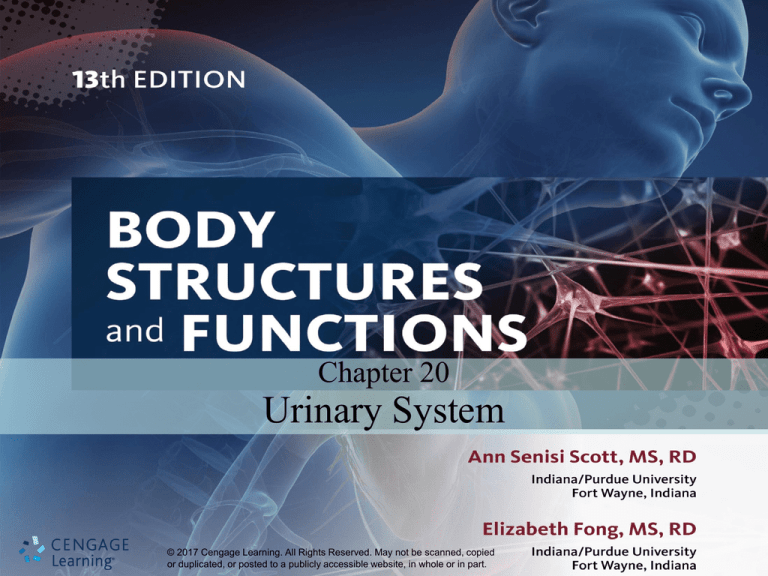
Chapter 20
Urinary System
© 2017 Cengage
© 2017
Learning.
Cengage
AllLearning.
Rights Reserved.
All RightsMay
Reserved.
not be scanned,
May not be
copied
scanned, copied
or duplicated,
or or
duplicated,
posted toor
a publicly
posted to
accessible
a publiclywebsite,
accessible
in whole
website,
or in
in part.
whole or in part.
Elimination of Waste
Products Summary
• Skin (perspiration)
• Dissolved salts
• Intestines (defecation)
• Solid wastes and water
• Lungs (exhalation)
• Carbon dioxide and water vapor
• Kidneys (urination)
• Nitrogenous wastes and salts dissolved in water to form urine
© 2017 Cengage Learning. All Rights Reserved. May not be scanned, copied
or duplicated, or posted to a publicly accessible website, in whole or in part.
Urinary System
• Excretion of nitrogenous wastes, salts, and
water
• Two kidneys
– Form the urine
• Two ureters
• One bladder
• One urethra
© 2017 Cengage Learning. All Rights Reserved. May not be scanned, copied
or duplicated, or posted to a publicly accessible website, in whole or in part.
Figure 20-1 The organs of the
urinary system of a female
© 2017 Cengage Learning. All Rights Reserved. May not be scanned, copied
or duplicated, or posted to a publicly accessible website, in whole or in part.
Functions of the Urinary System
•
•
•
•
Excretion
Aids in maintaining acid-base balance
Renin helps maintain blood pressure
Erythropoeitin stimulates red blood cell
production
• Secretion of waste products in the form of
urine
• Elimination of urine from the bladder where
it is stored
© 2017 Cengage Learning. All Rights Reserved. May not be scanned, copied
or duplicated, or posted to a publicly accessible website, in whole or in part.
Kidneys
• Two bean-shaped organs located
retroperitoneally
• Adipose capsule
• Renal fascia
• Hilum
• Renal pelvis
• Medulla and cortex
© 2017 Cengage Learning. All Rights Reserved. May not be scanned, copied
or duplicated, or posted to a publicly accessible website, in whole or in part.
Figure 20-2 The internal structure of
a kidney
© 2017 Cengage Learning. All Rights Reserved. May not be scanned, copied
or duplicated, or posted to a publicly accessible website, in whole or in part.
Medulla and Cortex
• Cortex is the outer granular layer
– Consists of the functional unit called the
nephron
• Medulla is the inner striated layer
– Consists of radially striated cones called renal
pyramids
– The papilla empties into the calyces, which join
together to empty into the renal pelvis
© 2017 Cengage Learning. All Rights Reserved. May not be scanned, copied
or duplicated, or posted to a publicly accessible website, in whole or in part.
Nephron (1 of 2)
•
•
•
•
•
•
Basic structural and functional unit
Each kidney has over 1 million
Afferent arteriole
Bowman’s capsule
Glomerulus
Efferent arteriole
© 2017 Cengage Learning. All Rights Reserved. May not be scanned, copied
or duplicated, or posted to a publicly accessible website, in whole or in part.
Nephron (2 of 2)
•
•
•
•
Proximal convoluted tubule (PCT)
Loop of Henle
Distal convoluted tubule (DCT)
Collecting tubule
© 2017 Cengage Learning. All Rights Reserved. May not be scanned, copied
or duplicated, or posted to a publicly accessible website, in whole or in part.
Figure 20-3 Structure of the nephron
© 2017 Cengage Learning. All Rights Reserved. May not be scanned, copied
or duplicated, or posted to a publicly accessible website, in whole or in part.
Path of Urine Formation (1 of 2)
Blood enters the afferent arteriole
Glomerulus Bowman’s capsule
Becomes filtrate PCT Loop of
Henle DCT Collecting tubule
© 2017 Cengage Learning. All Rights Reserved. May not be scanned, copied
or duplicated, or posted to a publicly accessible website, in whole or in part.
Path of Urine Formation (2 of 2)
Collecting tubule
– At collecting tubule, approximately 99% of the filtrate has
been reabsorbed
Formed urine goes to the renal pelvis
ureter bladder urethra urinary
meatus
© 2017 Cengage Learning. All Rights Reserved. May not be scanned, copied
or duplicated, or posted to a publicly accessible website, in whole or in part.
Urine Formation in the Nephron
•
•
•
•
Filtration
Reabsorption
Secretion
Urinary output and urinalysis values
© 2017 Cengage Learning. All Rights Reserved. May not be scanned, copied
or duplicated, or posted to a publicly accessible website, in whole or in part.
Figure 20-5 Filtration, reabsorption, and secretion are the main
functions of the nephrons
© 2017 Cengage Learning. All Rights Reserved. May not be scanned, copied
or duplicated, or posted to a publicly accessible website, in whole or in part.
Control of Urinary Secretion
• Chemical control
– Aldosterone
– ADH
– diuretics
●
Nervous control
– Action of nerve impulses on the blood vessels leading
to the kidney
© 2017 Cengage Learning. All Rights Reserved. May not be scanned, copied
or duplicated, or posted to a publicly accessible website, in whole or in part.
Urinary Output
• 1,000-2,000ml of urine/day
• Volume will vary with diet, fluid intake,
temperature and physical activity
• Urinalysis
– Examines the urine
– Most common noninvasive diagnostic test done
© 2017 Cengage Learning. All Rights Reserved. May not be scanned, copied
or duplicated, or posted to a publicly accessible website, in whole or in part.
Ureters
• Two ureters
– One for each kidney
•
•
•
•
Carries urine to the bladder for storage
About 10-12 inches long and ¼-inch wide
Mucous membranes line ureters
Smooth muscle fibers
– Peristalsis to push urine down the ureter to the bladder
© 2017 Cengage Learning. All Rights Reserved. May not be scanned, copied
or duplicated, or posted to a publicly accessible website, in whole or in part.
Urinary Bladder/Urethra
• Hollow muscular organ
• Stores up to about 1 pint (500 ml) of urine
• Involuntary contractions of the bladder can
be controlled to some extent by the nervous
system
• Urine leaves the bladder through the
urethra, then passes through the opening
called the urinary meatus
© 2017 Cengage Learning. All Rights Reserved. May not be scanned, copied
or duplicated, or posted to a publicly accessible website, in whole or in part.
Urination
• Micturition
• Level of urine in the bladder is sensed by
stretch receptors
• Requires coordinated contraction of the
bladder muscles and the relaxation of the
sphincters
© 2017 Cengage Learning. All Rights Reserved. May not be scanned, copied
or duplicated, or posted to a publicly accessible website, in whole or in part.
Disorders of the Urinary System
(1 of 2)
•
•
•
•
•
Acute kidney failure
Chronic renal failure
Glomerulonephritis
Acute glomerulonephritis
Chronic glomerulonephritis
© 2017 Cengage Learning. All Rights Reserved. May not be scanned, copied
or duplicated, or posted to a publicly accessible website, in whole or in part.
Disorders of the Urinary System
(2 of 2)
•
•
•
•
•
•
Hydronephrosis
Pyelitis/Pyelonephritis
Kidney stones or renal calculi
Cystitis
Incontinence
Neurogenic bladder
© 2017 Cengage Learning. All Rights Reserved. May not be scanned, copied
or duplicated, or posted to a publicly accessible website, in whole or in part.
Effects of Aging (1 of 2)
• Kidneys shrink
• Changes result in decreased renal blood
flow
• Kidney compromised in removing waste
products
• Decreased glomerular filtration rate
– Drug dosages have to be adjusted
© 2017 Cengage Learning. All Rights Reserved. May not be scanned, copied
or duplicated, or posted to a publicly accessible website, in whole or in part.
Effects of Aging (2 of 2)
• Glucose reabsorption also decreases
– Hyperglycemia
• Loss of muscle tone in the urinary bladder
• Urinary incontinence
© 2017 Cengage Learning. All Rights Reserved. May not be scanned, copied
or duplicated, or posted to a publicly accessible website, in whole or in part.
Dialysis
• Passage of dissolved molecules through a
semipermeable membrane
• Used for kidney failure
• Hemodialysis
• Peritoneal dialysis
© 2017 Cengage Learning. All Rights Reserved. May not be scanned, copied
or duplicated, or posted to a publicly accessible website, in whole or in part.
Kidney Transplants
• Living donor transplant
• Unrelated donor who has died
• Most important complication
– Rejection of kidney by the recipient
© 2017 Cengage Learning. All Rights Reserved. May not be scanned, copied
or duplicated, or posted to a publicly accessible website, in whole or in part.








